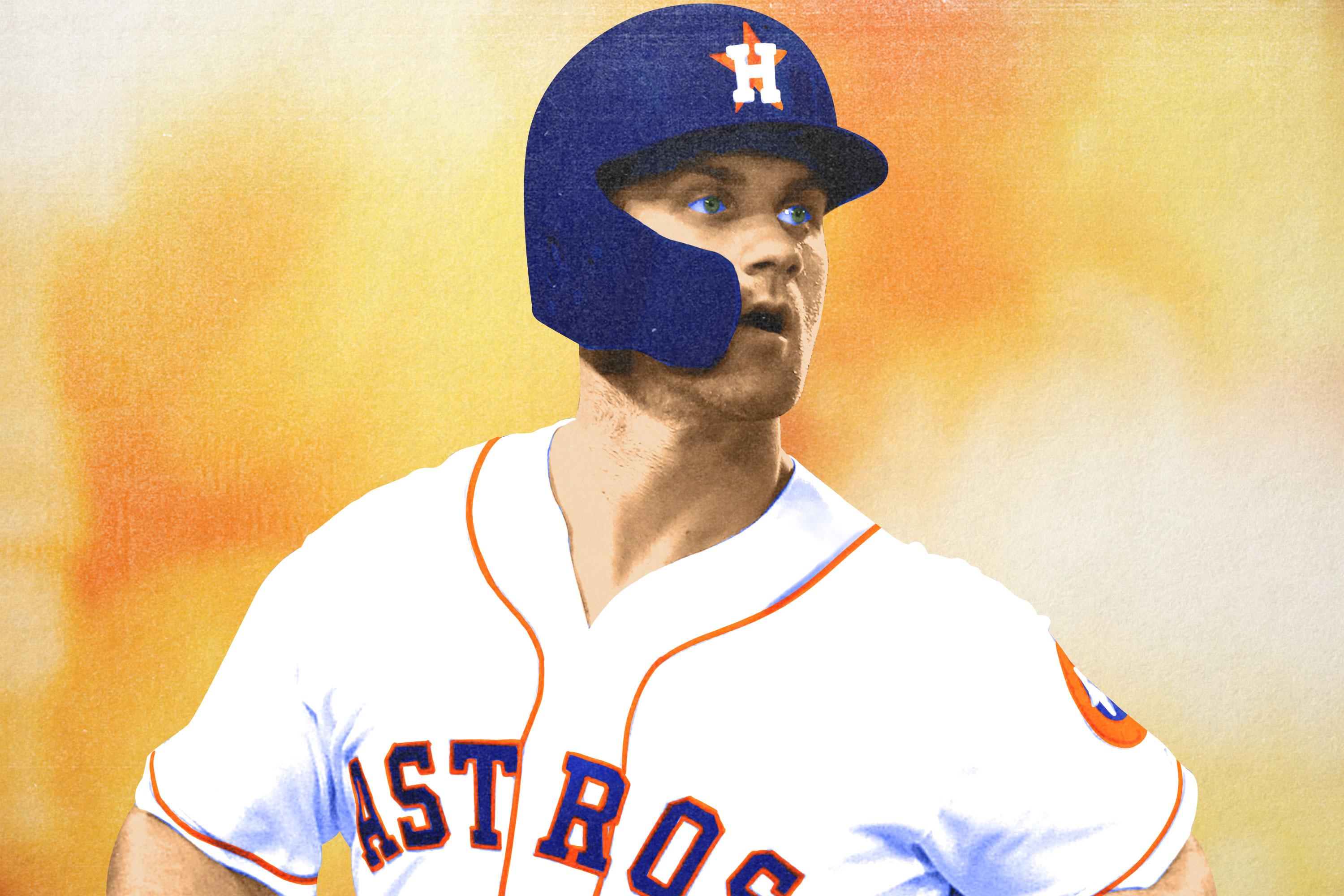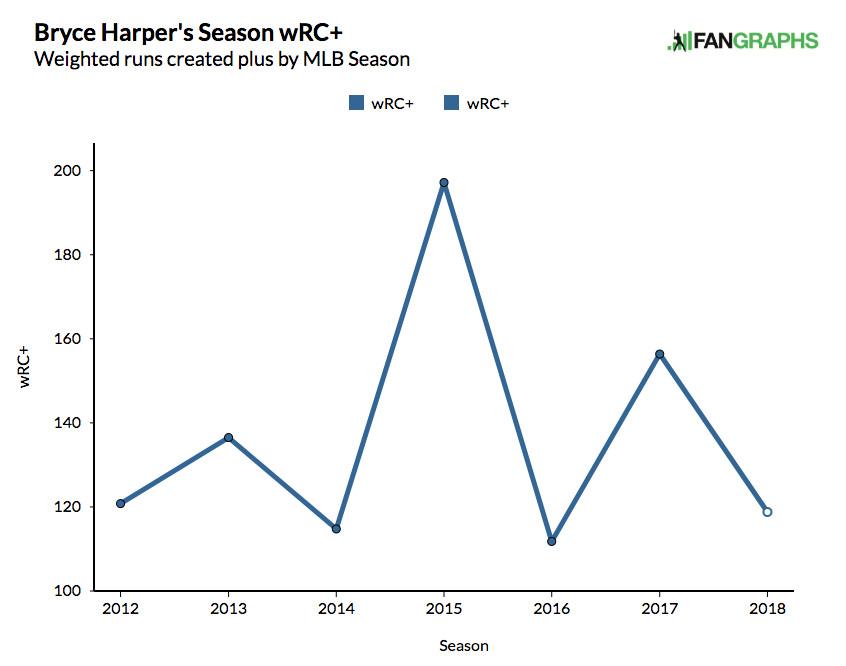The Astros Should Trade for Bryce Harper and Make the Rest of Baseball’s Contenders Cower in Fear
With Washington slipping further out of the playoff race, the Nationals should consider shipping off their free-agent-to-be—and who better to send him to than Houston, which has the fit, prospects, and precedent to pull off a deadline stunner
The last time the Nationals finished a season with a losing record, Bryce Harper was making his way through Single- and Double-A just a year after being drafted first overall in 2010. The outfield phenom arrived in D.C. in 2012, and the franchise arrived on the national stage that year, too, reaching the playoffs for the first time since 1981 and kick-starting a run of consistent, if cursed, contention.
The 2018 season is more than 100 games in, and Washington is in danger of recording its first losing record since Harper’s tenure began. After losing two of three games in Milwaukee, the Nationals’ record sits at 50–51, and their playoff position — once seen as a fait accompli — has never looked so perilous: They’re seven games back of Philadelphia in the NL East, and they trail the Brewers, Braves, Diamondbacks, Rockies, Pirates, Giants, and Cardinals in the NL’s wild-card congestion.
The Nationals have the NL’s second-worst record since the start of June, and as their playoff hopes dwindle with each passing loss, a once-unthinkable question grows more urgent: Could they actually trade Harper? The question might be rendered moot this weekend, as Washington plays Miami — the only team it has defeated in consecutive games in the past month — in its last four games before the July 31 deadline. But if Washington continues its stumble against the Marlins and the team reaches the end of the month with little realistic chance at a playoff berth, it probably does make sense to consider trading the franchise’s centerpiece.
The greatest unknown variable in this exercise is how trading Harper, who is a free agent after this season, might influence Washington’s contract negotiations with him this winter. Sending him to another team won’t necessarily ruin those talks before they even begin, though. Teams have traded players with expiring contracts only to engage with them a few months later — the Yankees signed Aroldis Chapman after trading him to the Cubs at the 2016 deadline, for instance, and the Red Sox almost brought back Jon Lester after trading him to Oakland two years prior. Both of those cases involved strategic retreats from the Yankees and Red Sox as they suffered through down years between bouts of contention, and Washington might do best to take a similar step now.
If the Nationals keep Harper through the rest of 2018 and extend him a qualifying offer, only for him to sign elsewhere, they won’t receive much in return. Because their payroll crosses the luxury-tax threshold this season, their compensation for losing Harper would be a pick after the fourth round. In this June’s draft, that selection would’ve been 135th overall, which is well past the point at which future top prospects are regularly available.
Not trading Harper, then, would leave Washington with a somewhat improved chance of contending in 2018, plus perhaps an improved chance of re-signing him after this year. But the Nationals would also have to contend with the downside of still-low competitive odds this season, and receiving only a mere lottery ticket in return if he signs elsewhere this winter. Trading him would effectively cinch Washington’s status as a playoff outsider this season, with the upside of helping the team’s chances beyond just this year.
And despite Harper, Daniel Murphy, and Gio González all reaching free agency after this season, should the Nationals lose those three, they won’t be doomed to a post-contention dive down the standings like the Royals or Tigers. Trea Turner, Juan Soto, and top prospect Victor Robles should form a solid position-player core for years to come, and Anthony Rendon, Max Scherzer, and Stephen Strasburg are all awards contenders under club control for at least another season, if not longer. Adding other good young players to the mix would help Washington’s chances in 2019 and beyond in a suddenly competitive NL East.
It’s always toughest for a team in the middle of the competitive spectrum to weigh that present-vs.-future calculus, but in this case, if the Nationals still trail more than half a dozen teams at the deadline, the future side of that scale seems a lot more welcoming.
Even if the Nationals were to explore a Harper trade, though, finding a partner could prove challenging. Last week’s Manny Machado trade works as a decent model for what Washington could demand in exchange for a rental who just started in the All-Star Game, as there is scant other precedent for a position player of this caliber being traded just a few months before reaching free agency. The expected return, then, would be something like a top-50 prospect plus fringe players performing well in the minors, with perhaps a bit of a surcharge because unlike with Baltimore, Washington could instead opt to stick to its current course and hope for a late-season run to the playoffs.
Not many teams combine both an immediate need for Harper with the ability to accommodate that asking price. Besides Washington, 12 teams have a losing record, obviating their need for a win-now player. Of the remaining 17 clubs, the Red Sox, Mariners, Cubs, Cardinals, Diamondbacks, and Giants all lack a top-50 prospect (by both FanGraphs’s and Baseball Prospectus’s midseason rankings), meaning they don’t have the minor league muscle to entice Washington.
That leaves 11 teams, but of those prospective suitors, the Yankees, Braves, Brewers, and Dodgers already have full outfields; the Phillies and Rockies have one prospect apiece with too much upside to trade for a rental (pitcher Sixto Sanchez and shortstop Brendan Rodgers, respectively) and nobody else in the remote vicinity; and the thought of Oakland, Tampa Bay, or Pittsburgh surrendering meaningful prospects for a run at a wild-card spot is the most fantastical hypothetical in this entire exercise.
Cleveland and Houston remain as the two teams without extreme complications, but the former is running somewhat short on prospect supply after sending catcher Francisco Mejía to San Diego last week, and it’s unlikely the club would deplete its remaining youth reserves for a rental bat. Cleveland does need an outfielder, but the team was content adding Jay Bruce in exchange for a Single-A relief pitcher last summer, and a similar move — maybe for Baltimore’s Adam Jones — is much more probable.
Houston, though, should have no such qualms. The Astros have the fit, the prospects, and, after turning a Justin Verlander trade into a World Series title last season, the precedent to make a move for Harper — and frankly, there would be no more frightening image for Houston’s AL competition than a lefty bat like Harper’s hitting among George Springer, Alex Bregman, José Altuve, and Carlos Correa.
A roster as loaded as Houston’s doesn’t truly need anything, per se, as the Astros could realistically claim the best lineup, best starting rotation, and second-best bullpen in the majors already, and they’re World Series favorites across a range of projection systems. But the one hole on the roster is, fittingly, a corner outfield spot, as the Astros rank just 24th in projected rest-of-season WAR from their left fielders. (Harper is a right fielder, but in this scenario, Houston would shift incumbent right fielder Josh Reddick over to left, where he’s played in spurts during the past two years.) Marwin González has once again become a below-average hitter after last season’s atypically productive showing at the plate, Derek Fisher never found his footing in the majors, and Tony Kemp has hit well in limited time this year but profiles best as a fourth outfielder rather than an everyday starter. Earlier this month, in an attempt to fix their problem, the Astros called up Kyle Tucker (no. 10 on FanGraphs’ midseason prospect ranking), their natural left fielder of the future. But he might not be ready for a playoff run in the present — in 13 games, the 21-year-old has batted .162/.225/.243, and he’s forecast as a roughly league-average hitter the rest of the way.
Particularly in the postseason, a team can never have too many good hitters; in last year’s playoffs, the Astros’ formidable lineup tilted excessively toward the top as the team’s bottom-of-the-order batters all struggled: Reddick hit just .169/.229/.185, González slashed .180/.275/.295, and catcher Brian McCann contributed a .175/.277/.263 line. And while that top was dynamic enough that it ultimately didn’t matter, manager A.J. Hinch would probably like some more length for his team’s repeat effort.
Moreover, even though Houston might have the most talented collection of batters in the majors, there’s no reason to expect diminishing returns from adding another to the mix. As FanGraphs’s Dave Cameron wrote a few summers ago, “In a good lineup, the whole really is greater than the sum of the individual parts, because good hitters create more opportunities for other good hitters to turn their production into runs.” In other words, Harper batting amid the All-Stars at the top of the lineup would theoretically boost the Astros’ run scoring even more than he would in another city, or than he already does in D.C.
Harper has admittedly been far less valuable this season than his reputation would suggest. His defense has been suspect, if not worst-right-fielder-in-the-majors bad, and he’s on a downslope of his career-long yo-yoing pattern at the plate. By WAR, FanGraphs shows that 107 position players have been more valuable than Harper this season, and Baseball-Reference balloons that number to 239.

Yet even with his problems this season, other underlying numbers show that Harper isn’t too far from his past excellence, at least at the plate. Last year, Harper’s expected weighted on-base average (xwOBA) — which estimates what production should be based on batted-ball data like exit velocity and launch angle — was .390. This year, it’s .393. His actual wOBA, though, has dropped from .416 to .352, which makes Harper’s decline look much steeper than it actually is. Opposing teams’ effective infield shifts have played a role in creating that discrepancy, but it’s not the only factor: Harper’s wOBA is 76 points lower than his xwOBA on fly balls and line drives, while last year the two were exactly the same.
Harper’s batting woes aren’t exclusively the result of bad luck — his contact rate is at a career low and yields a sizable strikeout increase compared with last year — but many of his issues at the plate appear to be. Harper is hitting just .230 on balls in play, the seventh-lowest mark among qualified hitters, but his career BABIP is .314 and his projected mark for the rest of the season is .301. There’s no reason to expect Harper to continue toiling this low, and every reason to expect that if a team adds the slugger for the stretch run, it’ll receive the sort of elite production Harper has proved himself capable of in the past.
The Astros’ top two prospects — Tucker and Forrest Whitley, who might be the best pitcher in the minors — are too valuable to trade for even peak Harper as just a three-month addition. But the club’s third-best prospect, Yordan Alvarez (no. 32 on FanGraphs’s midseason list and no. 27 at BP), could work as a centerpiece of the deal. The 21-year-old slugger’s reputation has been on the rise as he crushed Double-A pitching en route to a .325/.389/.615 slash line before receiving a promotion to Triple-A earlier this month. The 6-foot-5 225-pounder is likely a first baseman long term. But according to BP, he has a “massive bat” to compensate for that unflattering defensive projection, and he both generates hard contact due to tremendous raw power and “has a quality approach at the plate and a natural patience that plays well with his skill set.”
Houston wouldn’t have an issue finding worthwhile complementary players, either. Like Los Angeles, which turned a handful of unknown youngsters into desirable players to round out the Machado trade, and the Yankees, who used former 11th-round and 22nd-round draft picks to complete its Zach Britton acquisition earlier this week, Houston has crafted an exceptional player development system. In addition to Astros pitchers owning the highest collective strikeout rate in the majors, the franchise’s affiliates have the highest strikeout rate in the Triple-A Pacific Coast League, Double-A Texas League, High-A Carolina League, Single-A Midwest League, and short-season New York–Penn League. If Washington wants a few high-performing arms, well, Houston’s entire minor league system is populated with that exact player type, and the Astros can afford to lose a few of those pitchers because they have the ability to create new ones as replacements.
Ultimately, while this broad skeleton for a blockbuster deadline deal makes sense from both perspectives, it might be too far-fetched to come to fruition, either because Washington is loathe to trade its most recognizable player or because Houston is sufficiently secure with its internal options. But the Nationals would do their future selves a disservice if they continue to play sub-.500 ball and don’t consider trading Harper, and the Astros would hinder their present selves if they don’t at least pursue meaningful upgrades in advance of postseason matchups against a slate of AL juggernauts. Just last season, after all, the Astros gambled on an underperforming MVP whose peripheral indicators suggested he was on the verge of better results, and Verlander led the Astros to a title. A year later, Houston could go for a sequel.
All player statistics through Tuesday’s games.

